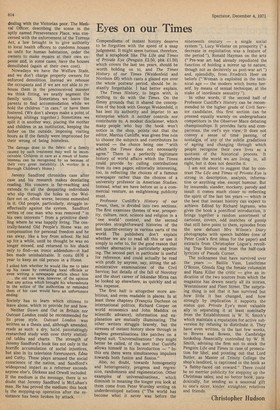Eyes on our Times
Compendiums of instant history deserve to be forgotten with the speed of a snap judgement. It might seem t urious, therefore, that a scrapbook like The Life and Times of Private Eye (Penguin £2.50, pbk £1.50) which covers the last ten years, should be worth holding on to, and The Times History of our Times (Weidenfeld and Nicolson £6) which casts a glazed eye over the whole postwar period, should be instantly forgettable. I had better explain.
The Times History, to begin with, is nothing to do with the Times. On the flimsy grounds that it shared the conception of the book with George Weidenfeld, it has lent its authority and imprint to an enterprise which it neither controls nor contributes to. A modest disclaimer, which many people who buy the book won't notice in the shop, points out that the editor, Marcus Cunliffe, was given free rein to choose the subjects and contributors he wanted — the choice being one "with which the Times does not necessarily agree." There is a perfectly legitimate history of world affairs which the Times could provide by culling contributions from its own pages; editorially interesting, too, in reflecting the choices of a famous newspaper rather than the choices of a university professor in American Studies. Instead, what we have before us is a commercial venture, an enlightening publicity stunt.
Professor Cunliffe's History of our Times, then, is divided into two sections. The first examines. themes of war, prosperity, culture, race, science and religion in a ' one world' context, and the second provides straightforward histories of the last quarter-century in various parts of the world. The publishers don't explain whether we are to read all this or use it simply to refer to, for the good reason that neither alternative is particularly appetising. The second part in particular is useful for reference, and could actually be read with profit by anyone, say, sitting the administrative examinations of the Civil Service; but details of the fall of Novotny and the short career of Iskandar Mirza can be looked up elsewhere, as quickly and at less expense.
The first half is altogether more ambitious, and even readable in places. In at least three chapters (Francois Duchene on international politics, Richard Cooper on world economics and John Maddox on scientific advance), information and explanation are mutually illuminating. The other writers struggle bravely, but the stresses of instant history show through in hapless generalisations like patches on a frayed suit. 'Universalisations ' they might better be called, of the sort that Cunliffe allows himself in his Introduction — "Inthis era there were simultaneous impulses towards both fusion and fission."
Also, no doubt, towards homogeneity and heterogeneity, progress and regression, randomness and regimentation. Other examples of universalisations, which diminish in meaning the 'longer you look at them come from Peter Worsley writing on underdeveloped nations (" The world has become what it never was before the
nineteenth century — a single social system "), Lucy Webster on prosperity (" a decrease in exploitation was a feature of the period "), Ronald Hayman on the arts (" Pre-war art had already repudiated the function of holding a mirror up to nature, though not as decisively as post-war art ") and, splendidly, from Friedrich Heer on beliefs (" Woman is exploited in the technical age — the modern witch burns herself, by means of sexual technique, at the stake of inordinate sexuality.").
In other words, if the second half of Professor Cunliffe's History can be recommended to the higher grade of Civil Service candidates, this first section can 'be pressed equally warmly on undergraduate competitors in the Observer Mace debating championships. It provides facts and comparisons, the owl's eye view. It does not convey a sense of time passing, of nostalgia, of any of the subtle gradations of ageing and changing through which people recognise their own lives as a quotient of the historical process. It analyses the world we are living in, all right, but it does not describe it.
I am not about to suggest that by contrast The Life and Times of Private Eye is strong in description, analysis, information or anything else, except humour. But by innuendo, slander, mockery, parody and insult it comes much closer to reflecting the spirit of the last ten years — which is the best that instant history can expect to achieve. Edited by Richard Ingrams, who gives the book a pontifical introduction, it brings together a random assortment of cartoons, covers, odd snatches of gossip that still have point to them, episodes from the now defunct Mrs Wilson's Diary photographs with speech bubbles (one of Peter Cook's first ideas for the paper) and extracts from Christopher Logue's revolting True Stories and from the half-cock lyricists of Pseuds Corner.
The nicknames that have survived over the years — Baillie Vass, Lunchtime O'Booze, Glenda Slag the female columnist and Hans Killer the critic — give an indication of the two sources from which the magazine has drawn nearly all its stories, Westminster and Fleet Street. The surprising thing is not that it has survived but how little it has changed, and how strongly by implication it supports the status quo. Private Eye's most valuable ally in separating it at least nominally from the Establishment is W. H. Smith's which maintain a reputation for active subversion by refusing to distribute it. They have even written, in the last few weeks, to Bowes and Bowes, the Cambridge bookshop financially controlled by W. H. Smith, advising the firm not to stock the Penguin Life and Times in case of prosecution for 'libel, and pointing out that Lord Butler, as Master of Trinity College the shop's landlord, is captioned in the book as "a flabby-faced old coward." There could be no merrier publicity for stepping up the Christmas sales; and no better book, paradoxically, for sending as a seasonal gift to one's nicer, kinder, straighter, relatives and friends.










































 Previous page
Previous page